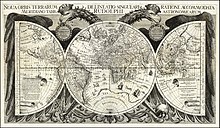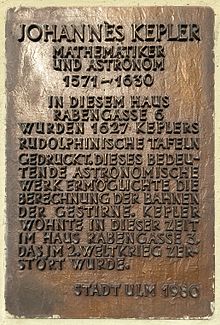Rudolfine tablets

The Rudolfinische Tafeln (Latin: Tabulæ Rudolphinæ ) by Johannes Kepler represent a collection of tables, mathematical principles, calculation rules with examples, especially rules for predicting the planetary positions . They are the basis for all kinds of astronomical and astrological calculations (e.g. eclipses, Easter dates, horoscope constellations).
The tables were more accurate than the Alfonsine tables from the 13th century and the Tabulæ Prutenicæ Coelestium Motuum calculated by Erasmus Reinhold in 1551 . The mean error between the predicted and observed planetary position could thus be reduced from five degrees to ten minutes . The work also contains refraction tables , logarithms , a directory of the cities of the world and a catalog of 1,005 star words based on the work of Tycho Brahe .
After Kepler had become Tycho Brahe's assistant in Prague in 1600 , Brahe and Kepler received an order from Emperor Rudolf II to calculate new, more precise planetary tables , which were named after the Emperor Rudolfinische Tafeln ( Latin Tabulæ Rudolphinæ ). When Tycho Brahe died in October 1601, Kepler succeeded him as the imperial mathematician of Rudolf II and continued to work alone on the tablets. In May 1612, Kepler got a job in Linz , where, in addition to surveying Upper Austria, he continued to work on the Rudolfinische Tafeln and the Harmonices mundi libri V , the five books on world harmonics . The Harmonices mundi libri V went to print in 1619, but the publication of the Rudolfinische Tafeln was unexpectedly delayed when, during the Upper Austrian Peasants' War in Linz in 1626, Hans Planck's printing works, in which the Tabulae Rudolfinae were to be printed, went up in flames. Kepler then moved to Ulm (1626–1627) in order to finish the panels there in September 1627. The world map was added to the work only later; it remains Kepler's only cartographic work. (The map of Austria ob der Enns was not created by Kepler, but by Abraham [? -?] And above all Israel [~ 1577–1617] Holzwurm.)
The Rudolfinische Tafeln were the last of the main works of Kepler, which appeared during his lifetime, and represent a remarkable achievement in practical astronomy . The work formed the basis of many astronomical calculations up to the 18th century. The English mathematician and physicist Sir Isaac Newton relied on Kepler's theories and observations in formulating his theory of gravitational force . With the help of the Rudolfinische Tafeln Adam Schall von Bell was able to complete the reform of the Chinese calendar begun by Johannes Schreck on behalf of the Chinese Emperor Xu Guangqi in 1635.
The frontispiece designed by Kepler was executed by the Frankfurt copper engraver Georg Keller (in the copper engraving in the base: Georg Celer sculpsit Norimberga ). It shows an allegory on the history of astronomy and its auxiliary sciences with a wealth of motifs. At one point there is also a self-portrait of Kepler, with a pointed cap and coat because of the nightly cold when staring. On his table is a small copy of the temple roof, which he created symbolically with the discovery of Kepler's laws .
On November 1, 1627, Johannes Kepler provided one copy of the work with a handwritten dedication to Duke August von Braunschweig-Lüneburg ; it is still in the Herzog August Library in Wolfenbüttel today .
See also
literature
- Johannes Kepler: Collected Works. Vol. X: Tabulae Rudolphinae. Edited by Franz Hammer. Beck, Munich, 1969
- Jürgen Reichert (Ed.): Kepler Johannes. The Rudolphine tablets. 2014, ISBN 978-3-8260-5352-8
- Hans-Joachim Albinus, Detlef Suckrau: Reminiscences of Johannes Kepler's stay in Ulm 1626-1627. New, strange and unsolved puzzles. Ulm and Oberschwaben, Vol. 61 (2019), pp. 175–211 (Chapter 2 on the Tabulae Rudolphinae and their printing in Ulm)
- Nicholas Jardine, Elisabeth Leedham-Green, Christopher Lewis: Johann Baptist Hebenstreit's Idyll on the Temple of Urania, the Frontispiece Image of Kepler's Rudolphine Tables. Part 1: Context and Significance. Journal for the History of Astronomy 45 (2014) pp. 1-19
- Elisabeth Leedham-Green, Nicholas Jardine, Christopher Lewis, Isla Fay: Johann Baptist Hebenstreit's Idyll on the Temple of Urania, the Frontispiece Image of Kepler's Rudolphine Tables. Part 2: Annotated Translation. In: Journal for the History of Astronomy 45 (2014) pp. 20–34
- Arnulf Arwed: The cover picture of the Tabulae Rudolphinae of Johannes Kepler. On the draft, execution, poetic explanation and models of a scientific allegory. Journal of the German Association for Art Research 54/55 (2000/01) pp. 176–198
- Peter H. Meurer : The work history of the world map by Johannes Kepler and Philipp Eckebrecht (1630/58). Cartographica Helvetica, 49 (2014), pp. 27-38
- Erich Woldan: Kepler as a cartographer. Haase, Rudolf (Ed.): Kepler Symposium. On the 350th anniversary of Johannes Kepler's death. 25.-28. September 1980 as part of the International Bruckner Festival '80 Linz. Report. Linz Event Society, Linz, 1981, pp. 133–135
Web links
- Digitized: Tabulæ Rudolphinæ - Kiel University Library - Bartsch Edition from 1627.
- Wiener Zeitung : Christian Pinter: Foundations of the Universe ( Memento from November 6, 2005 in the Internet Archive )

